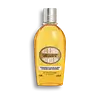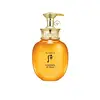What's inside
What's inside
 Key Ingredients
Key Ingredients

 Benefits
Benefits

 Concerns
Concerns

 Ingredients Side-by-side
Ingredients Side-by-side

Vitis Vinifera Seed Oil
EmollientTipa-Laureth Sulfate
CleansingLaureth-3
EmulsifyingCaprylic/Capric Triglyceride
MaskingParfum
MaskingCocamide Mea
EmulsifyingPropylene Glycol
HumectantSorbitan Oleate
EmulsifyingPrunus Amygdalus Dulcis Oil
Skin ConditioningCitrus Aurantium Bergamia Fruit Oil
MaskingHelianthus Annuus Seed Oil
EmollientRosmarinus Officinalis Leaf Extract
AntimicrobialTocopherol
AntioxidantWater
Skin ConditioningLimonene
PerfumingCoumarin
PerfumingLinalool
PerfumingVitis Vinifera Seed Oil, Tipa-Laureth Sulfate, Laureth-3, Caprylic/Capric Triglyceride, Parfum, Cocamide Mea, Propylene Glycol, Sorbitan Oleate, Prunus Amygdalus Dulcis Oil, Citrus Aurantium Bergamia Fruit Oil, Helianthus Annuus Seed Oil, Rosmarinus Officinalis Leaf Extract, Tocopherol, Water, Limonene, Coumarin, Linalool
Water
Skin ConditioningCocamidopropyl Betaine
CleansingCocamide Methyl Mea
Sodium Cocoyl Glycinate
CleansingGlycerin
HumectantSantalum Album Oil
MaskingVelvet Extract
HumectantCornus Officinalis Fruit Extract
Skin ConditioningThymus Vulgaris Extract
PerfumingAngelica Acutiloba Root Extract
Skin ConditioningEugenia Caryophyllus Bud Extract
PerfumingSantalum Album Wood Extract
PerfumingNardostachys Chinensis Root Extract
Skin ConditioningZingiber Officinale Root Extract
MaskingCitrus Nobilis Peel Extract
MaskingFoeniculum Vulgare Fruit Extract
EmollientAgastache Rugosa Extract
AntimicrobialPoria Cocos Extract
Skin ConditioningMorus Alba Bark Extract
Skin ConditioningPaeonia Lactiflora Root Extract
Skin ConditioningGinkgo Biloba Nut Extract
Skin ConditioningPanax Ginseng Root Extract
EmollientAtractylodes Japonica Rhizome Extract
Skin ConditioningTribulus Terrestris Fruit Extract
Skin ConditioningAmpelopsis Japonica Root Extract
Skin ConditioningPogostemon Cablin Leaf Extract
PerfumingPrunus Armeniaca Kernel Extract
Skin ConditioningCoix Lacryma-Jobi Ma-Yuen Seed Extract
Skin ConditioningPolygonum Multiflorum Root Extract
Skin ConditioningRehmannia Chinensis Root Extract
Skin ConditioningChrysanthemum Indicum Flower Extract
Skin ConditioningCyperus Rotundus Root Extract
Skin ConditioningChaenomeles Sinensis Fruit Extract
AntioxidantPrunella Vulgaris Leaf Extract
Skin ConditioningCassia Obtusifolia Seed Extract
Skin ConditioningEucommia Ulmoides Bark Extract
AntioxidantLycium Chinense Fruit Extract
AntioxidantPoria Cocos Sclerotium Extract
AstringentCaprylyl Glycol
Emollient1,2-Hexanediol
Skin ConditioningPEG-40 Hydrogenated Castor Oil
EmulsifyingCitric Acid
BufferingSodium Chloride
MaskingDipropylene Glycol
HumectantButylene Glycol
HumectantAlcohol
AntimicrobialTetrasodium EDTA
Ethylhexyl Methoxycinnamate
UV AbsorberCI 15985
Cosmetic ColorantCI 16035
Cosmetic ColorantParfum
MaskingAlpha-Isomethyl Ionone
PerfumingCitronellol
PerfumingHexyl Cinnamal
PerfumingLimonene
PerfumingLinalool
PerfumingWater, Cocamidopropyl Betaine, Cocamide Methyl Mea, Sodium Cocoyl Glycinate, Glycerin, Santalum Album Oil, Velvet Extract, Cornus Officinalis Fruit Extract, Thymus Vulgaris Extract, Angelica Acutiloba Root Extract, Eugenia Caryophyllus Bud Extract, Santalum Album Wood Extract, Nardostachys Chinensis Root Extract, Zingiber Officinale Root Extract, Citrus Nobilis Peel Extract, Foeniculum Vulgare Fruit Extract, Agastache Rugosa Extract, Poria Cocos Extract, Morus Alba Bark Extract, Paeonia Lactiflora Root Extract, Ginkgo Biloba Nut Extract, Panax Ginseng Root Extract, Atractylodes Japonica Rhizome Extract, Tribulus Terrestris Fruit Extract, Ampelopsis Japonica Root Extract, Pogostemon Cablin Leaf Extract, Prunus Armeniaca Kernel Extract, Coix Lacryma-Jobi Ma-Yuen Seed Extract, Polygonum Multiflorum Root Extract, Rehmannia Chinensis Root Extract, Chrysanthemum Indicum Flower Extract, Cyperus Rotundus Root Extract, Chaenomeles Sinensis Fruit Extract, Prunella Vulgaris Leaf Extract, Cassia Obtusifolia Seed Extract, Eucommia Ulmoides Bark Extract, Lycium Chinense Fruit Extract, Poria Cocos Sclerotium Extract, Caprylyl Glycol, 1,2-Hexanediol, PEG-40 Hydrogenated Castor Oil, Citric Acid, Sodium Chloride, Dipropylene Glycol, Butylene Glycol, Alcohol, Tetrasodium EDTA, Ethylhexyl Methoxycinnamate, CI 15985, CI 16035, Parfum, Alpha-Isomethyl Ionone, Citronellol, Hexyl Cinnamal, Limonene, Linalool
 Reviews
Reviews

Ingredients Explained
These ingredients are found in both products.
Ingredients higher up in an ingredient list are typically present in a larger amount.
Limonene is a fragrance that adds scent and taste to a formulation.
It's found in the peel oil of citrus fruits and other plants such as lavender and eucalyptus. The scent of limonene is generally described as "sweet citrus".
Limonene acts as an antioxidant, meaning it helps neutralize free radicals.
When exposed to air, oxidized limonene may sensitize the skin. Because of this, limonene is often avoided by people with sensitive skin.
The term 'fragrance' is not regulated in many countries. In many cases, it is up to the brand to define this term. For instance, many brands choose to label themselves as "fragrance-free" because they are not using synthetic fragrances. However, their products may still contain ingredients such as essential oils that are considered a fragrance.
Learn more about LimoneneLinalool is a fragrance and helps add scent to products. It's derived from common plants such as cinnamon, mint, citrus, and lavender.
Like Limonene, this ingredient oxidizes when exposed to air. Oxidized linalool can cause allergies and skin sensitivity.
This ingredient has a scent that is floral, spicy tropical, and citrus-like.
Learn more about LinaloolParfum is a catch-all term for an ingredient or more that is used to give a scent to products.
Also called "fragrance", this ingredient can be a blend of hundreds of chemicals or plant oils. This means every product with "fragrance" or "parfum" in the ingredients list is a different mixture.
For instance, Habanolide is a proprietary trade name for a specific aroma chemical. When used as a fragrance ingredient in cosmetics, most aroma chemicals fall under the broad labeling category of “FRAGRANCE” or “PARFUM” according to EU and US regulations.
The term 'parfum' or 'fragrance' is not regulated in many countries. In many cases, it is up to the brand to define this term.
For instance, many brands choose to label themselves as "fragrance-free" because they are not using synthetic fragrances. However, their products may still contain ingredients such as essential oils that are considered a fragrance by INCI standards.
One example is Calendula flower extract. Calendula is an essential oil that still imparts a scent or 'fragrance'.
Depending on the blend, the ingredients in the mixture can cause allergies and sensitivities on the skin. Some ingredients that are known EU allergens include linalool and citronellol.
Parfum can also be used to mask or cover an unpleasant scent.
The bottom line is: not all fragrances/parfum/ingredients are created equally. If you are worried about fragrances, we recommend taking a closer look at an ingredient. And of course, we always recommend speaking with a professional.
Learn more about ParfumWater. It's the most common cosmetic ingredient of all. You'll usually see it at the top of ingredient lists, meaning that it makes up the largest part of the product.
So why is it so popular? Water most often acts as a solvent - this means that it helps dissolve other ingredients into the formulation.
You'll also recognize water as that liquid we all need to stay alive. If you see this, drink a glass of water. Stay hydrated!
Learn more about Water